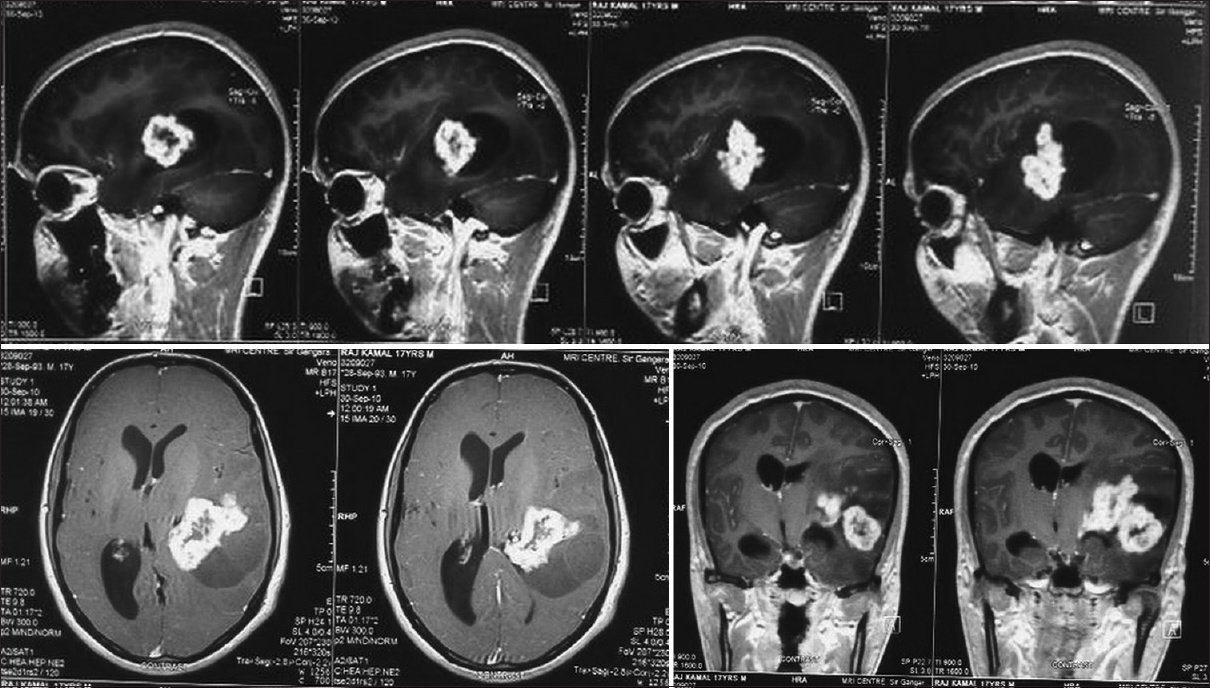- Department of Neurosurgery, Sri Ganga Ram Hospital, New Delhi, India
Correspondence Address:
Satnam Singh Chhabra
Department of Neurosurgery, Sri Ganga Ram Hospital, New Delhi, India
DOI:10.4103/2152-7806.195584
Copyright: © 2016 Surgical Neurology International This is an open access article distributed under the terms of the Creative Commons Attribution-NonCommercial-ShareAlike 3.0 License, which allows others to remix, tweak, and build upon the work non-commercially, as long as the author is credited and the new creations are licensed under the identical terms.How to cite this article: Anshul Gupta, Divyam Sharma, Gurupal Singh Dhillon, Satnam Singh Chhabra. Intracranial periventricular supratentorial intraparenchymal schwannoma. 12-Dec-2016;7:
How to cite this URL: Anshul Gupta, Divyam Sharma, Gurupal Singh Dhillon, Satnam Singh Chhabra. Intracranial periventricular supratentorial intraparenchymal schwannoma. 12-Dec-2016;7:. Available from: http://surgicalneurologyint.com/surgicalint_articles/intracranial-periventricular-supratentorial-intraparenchymal-schwannoma/
Abstract
Background:Intraparenchymal schwannomas in the central nervous system are very rare. Because most of these are benign, complete excision is the treatment of choice. Further, their radiological findings are difficult to differentiate from glioma. Because Schwann cells are not indigenous to cerebral parenchyma, a lot of speculation has been attached to their origin.
Case Description:We report one such rare case of a 17-year-old male who presented to us with a history of headache and vomiting. Neuroradiological findings were suggestive of left temporoparietal solid cystic lesion with enhancement of solid component, suggestive of high grade glioma.
Conclusion:Intraoperative impression was that of a low-grade glioma but histopathological features were represented as schwannoma.
Keywords: Intraparenchymal schwannoma, periventricular, solid cystic, supratentorial
INTRODUCTION
Intracranial schwannomas have an incidence of approximately 8% of all primary brain tumors. Intraparenchymal schwannomas are extremely rare. A recent literature survey reported a total of 71 such cases reported in the literature.[
CASE REPORT
A 17-year-old male presented to us with a history of mild headache for the last 14 years, with a progressive increase in severity for the last 10 days, which was associated with repeated vomiting for the last 5 days. Patient was admitted, and complete neurological examination was normal except bilateral papilledema; there were no signs or family history of NF. Magnetic resonance imaging (MRI) brain was done that revealed a left temporoparietal, intracranial, periventricular solid cystic mass lesion [
The patient underwent left temporoparietal craniotomy and gross total tumor excision under general anesthesia. The tumor was well-demarcated from surrounding parenchyma and had no intraventricular connection. The solid component was moderately vascular, firm, and pinkish-grey in color. Postoperative MRI scan was suggestive of near total removal of the tumor [
Histopathological examination of the surgical specimen revealed the tumor to have typical schwannoma features. It had areas of high cellularity with interlacing fascicles of spindle cells with nuclear palisading (Antoni type A) and other areas of less cellularity with haphazardly oriented and loosely arranged tumor cells in a myxoid matrix (Antoni type B). No necrosis was observed. There was clean-cut demarcation between the tumor cells and the surrounding parenchymal cells. Reticulin stain showed a rich pericellular retriculin staining in Antoni B areas [
DISCUSSION
Schwannomas are benign tumors accounting for approximately 8% of all intracranial lesions. Very few documented cases have been reported in the literature so far. Out of these, only four were reported to be associated with NF[
Depending on their origin, intraparenchymal schwannomas have been broadly classified into two groups; developmental and nondevelopmental. The developmental theory is based on the transformation of the mesenchymal pial cells[
Males are found to be more affected then females, and these generally occur either in the first two decades with a slow indolent course or in elderly with a rapid course.[
Histopathologically, the detection of Antoni A and Antoni B structures, Verocay bodies, infiltration by foamy macrophages, and vascular hyalinization usually suffices for the recognition of schwannomas. Immunohistochemistry finding showed reactivity of both S100 protein and Vimentin and negativity of glial fibrillary acidic protein.
The treatment of choice is complete surgical excision which is associated with cure and good long-term outcome.
CONCLUSION
Because of the rarity of intraparenchymal schwannoma and close radiological resemblance to gliomas, preoperative diagnosis is difficult. Thus, any intraparenchymal lesion radiologically suspected to be glioma but having a periventricular location, peritumoral edema, and associated with cyst or calcification should have a differential diagnosis of intraparenchymal schwannoma in the surgeon's mind. Such lesion should be, as far as possible, completely excised.
Financial support and sponsorship
Nil.
Conflicts of interest
There are no conflicts of interest.
References
1. Aryanpur J, Long DM. Schwannoma of the medulla oblongata. Case report. J Neurosurg. 1988. 69: 446-9
2. Beauchesne P, Mosnier JF, Schmitt T, Brunon J. Malignant nerve sheath tumor of the right cerebral peduncle: Case report. Neurosurgery. 2004. 54: 500-4
3. Casadei GP, Komori T, Scheithauer BW, Miller GM, Parisi JE, Kelly PJ. Intracranial parenchymal schwannoma. A clinicopathological and neuroim aging study of nine cases. J Neurosurg. 1993. 79: 217-22
4. De Cauwer H, Bogers JP, Duwel V, den Hauwe V, Croese P, Van Marck E. An intracerebral intraparenchymatous triton tumor in a man with neurofibromatosis. J Neurol. 2007. 254: 1009-11
5. Haga Y, Shoji H, Oguro K, Mori S, Kawi T, Shinoda S. Intracerebral schwannoma-Case report. Neurol Med Chir. 1997. 37: 551-5
6. Horn EM, Zabramski JM, Lanzino G, Coons SW. Intracerebral schwannomas: Case report and review of the literature. Barrow Quarterly. 2006. p. 22-
7. Mardi K, Sharma J. Intracranial cystic (ancient) schwannoma of the temporal lobe: A rare occurrence. Internet J Pathol. 2007. p. 7-
8. Nelson E, Rennels M. Innervation of intracranial arteries. Brain. 1970. 93: 475-90
9. Redekop G, Elisevich K, Gilbert J. Fourth ventricular schwannoma. Case report. J Neurosurg. 1990. 73: 777-81
10. Russell DS, Rubinstein LJ.editorsPathology of Tumors of the Nervous System. London, UK: Edward Arnold; 1989. p.








